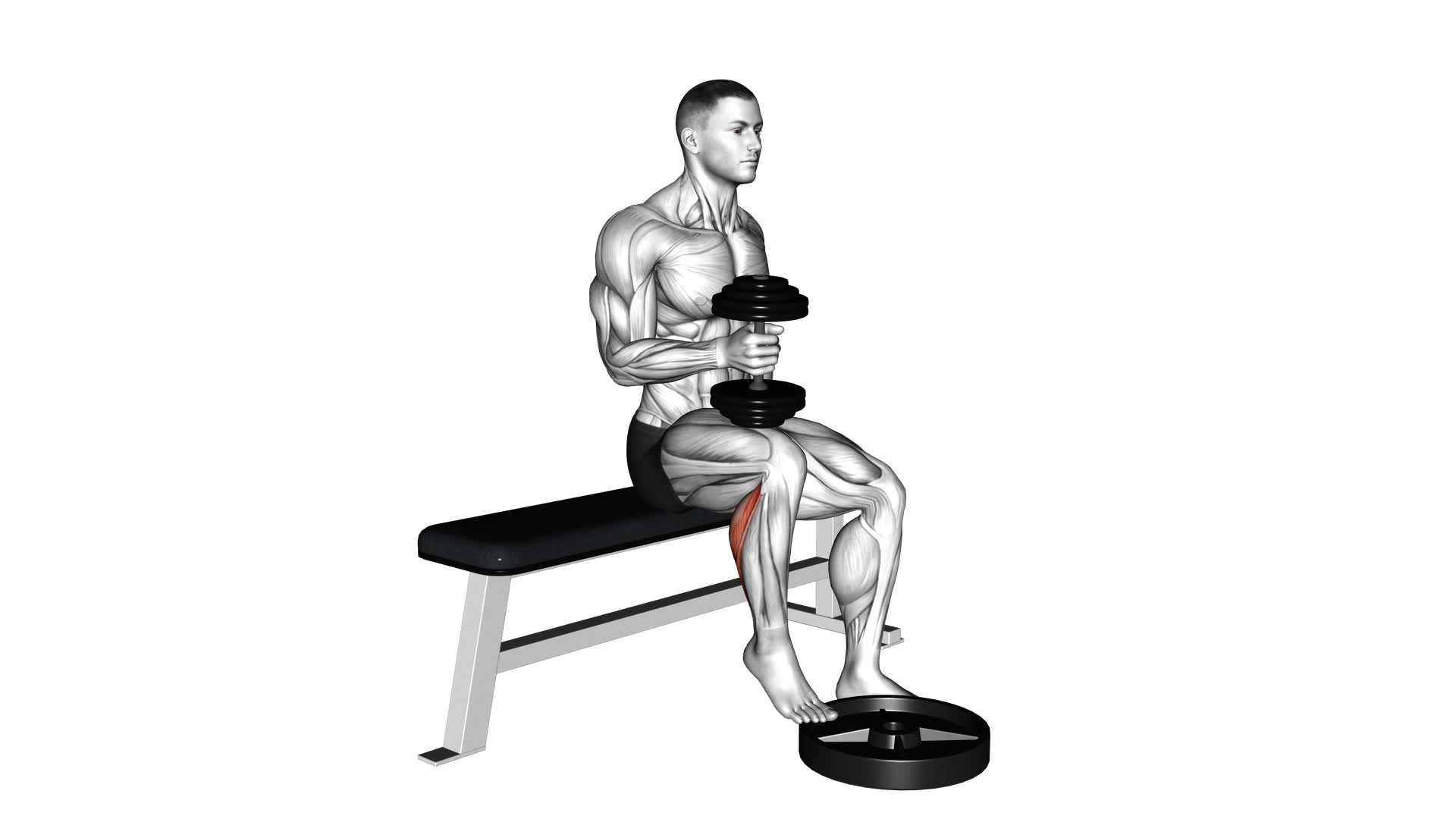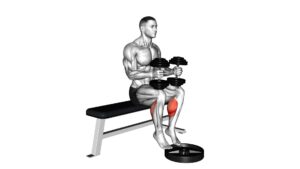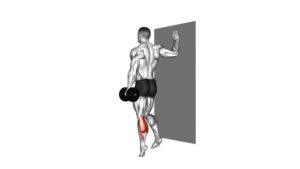Dumbbell Seated One Leg Calf Raise Hammer Grip – Video Exercise Guide & Tips

Are you looking for a challenging calf exercise that targets your muscles in a seated position? Look no further than the Dumbbell Seated One Leg Calf Raise with a Hammer Grip!
Watch This Exercise Video
This video exercise guide and tips article will show you the proper form and technique, as well as variations for increased difficulty.
Avoid common mistakes and maximize your results with our helpful tips.
Get ready to strengthen those calves and achieve your fitness goals!
Key Takeaways
- Dumbbell seated one leg calf raise strengthens and tones calf muscles.
- Different foot placements target different areas of the calf muscles.
- Avoid using excess momentum and maintain control throughout the movement.
- Strong and stable ankles are essential for balance and overall performance.
Benefits of Dumbbell Seated One Leg Calf Raise
One of the benefits of performing the dumbbell seated one leg calf raise is that it helps to strengthen and tone your calf muscles through a controlled and targeted exercise. This exercise specifically targets the gastrocnemius and soleus muscles, which make up the calf muscles. By performing this exercise, you're able to activate and engage these muscles, leading to increased strength and definition in your calves.
In addition to calf muscle activation, the dumbbell seated one leg calf raise also helps to improve ankle stability. The exercise requires you to balance on one leg while raising and lowering your heel. This challenges your ankle joint and the surrounding muscles, including the muscles that control ankle stability. By regularly performing this exercise, you can enhance the strength and stability of your ankles, which can be beneficial for activities that require balance and agility, such as running, jumping, and sports.
Proper Form and Technique
When performing the Dumbbell Seated One Leg Calf Raise with a hammer grip, it's important to pay attention to your foot placement. Placing your foot correctly on the edge of the platform ensures optimal engagement of the calf muscles.
Additionally, be careful to avoid using excess momentum during the exercise, as this can diminish the effectiveness of the movement.
Foot Placement Importance
To achieve proper form and technique in the Dumbbell Seated One Leg Calf Raise Hammer Grip exercise, you must ensure precise foot placement. The position of your foot during this exercise is crucial for maximizing its effectiveness and minimizing the risk of injury.
There are different foot placement variations you can try to target different areas of your calf muscles. Placing your foot straight and parallel to the floor primarily targets the middle and outer calf muscles. If you angle your foot inward, it will engage the inner calf muscles more.
Additionally, proper foot placement requires good ankle mobility. Adequate ankle mobility allows for a full range of motion during the exercise, ensuring that the calf muscles are properly stretched and contracted.
Avoiding Excess Momentum
To avoid excess momentum and ensure proper form and technique in the Dumbbell Seated One Leg Calf Raise Hammer Grip exercise, focus on maintaining control throughout the movement. This is crucial for avoiding injury and maximizing muscle activation.
Begin by sitting upright on a bench with a dumbbell resting on your thigh and your foot positioned on a raised platform, toes pointing forward. As you raise your heel, use a slow and controlled motion, concentrating on contracting your calf muscle.
Avoid any jerking or bouncing movements, as this can lead to injury and reduce the effectiveness of the exercise. By maintaining control, you engage the targeted muscles more effectively, ensuring a safe and efficient workout.
Maintaining Proper Balance
Ensure proper balance in the Dumbbell Seated One Leg Calf Raise Hammer Grip exercise by maintaining control and stability throughout the movement.
Ankle stability plays a crucial role in maintaining balance during this exercise. Strong and stable ankles are essential for preventing injuries and improving overall performance.
Incorporating balance training into your workouts can help enhance ankle stability and improve your ability to maintain proper balance during exercises like the Dumbbell Seated One Leg Calf Raise Hammer Grip.
Balance training exercises such as standing on one leg, using a balance board, or performing single-leg squats can help strengthen the muscles around the ankle and improve proprioception.
Variation for Increased Difficulty
To increase the difficulty of the dumbbell seated one leg calf raise hammer grip exercise, try adding extra weight. By incorporating increased resistance, you can challenge your calf muscles even more and promote greater muscle activation. The added weight will increase the load on your calves, forcing them to work harder and adapt to the increased demand. This variation is especially effective for individuals who've already mastered the exercise with bodyweight alone and are looking to progress further.
To perform the variation, hold a dumbbell in your hand while seated, placing it on top of your thigh. Keep your back straight and core engaged throughout the exercise. Rest the balls of your feet on the edge of a step or elevated surface, with your heel hanging off. Slowly raise your heel as high as possible, squeezing your calf muscles at the top of the movement. Lower your heel back down and repeat for the desired number of repetitions.
Adding extra weight to the dumbbell seated one leg calf raise hammer grip exercise is an excellent way to continue challenging your calf muscles and promoting strength gains. However, it's important to avoid common mistakes that can hinder your progress and increase the risk of injury.
Common Mistakes to Avoid
One common mistake to avoid when performing the dumbbell seated one leg calf raise hammer grip exercise is neglecting proper form. To ensure success and maximize the benefits of this exercise, keep the following tips in mind:
- Using excessive weight: Adding too much weight can compromise your form and increase the risk of injury. Start with a manageable weight and gradually increase it as you become more comfortable and confident.
- Lifting the heel too high: Avoid lifting your heel too high at the top of the movement. This can shift the focus away from the calf muscles and put unnecessary strain on the Achilles tendon. Instead, aim for a controlled and smooth movement throughout the exercise.
- Not maintaining a neutral spine: It's important to maintain a neutral spine throughout the exercise to prevent strain on your lower back. Keep your core engaged and your back straight during the entire movement.
- Neglecting the eccentric phase: The lowering phase of the exercise, also known as the eccentric phase, is just as important as the lifting phase. Control the descent of the weight and resist the urge to let it drop quickly.
Tips for Maximizing Results
To maximize your results with the dumbbell seated one leg calf raise hammer grip exercise, it's important to focus on proper form techniques.
This includes keeping your back straight, engaging your core, and ensuring a full range of motion.
Additionally, progression and variation options, such as increasing the weight or adding pauses in the movement, can help challenge your calf muscles even further and lead to better results.
Proper Form Techniques
For maximizing results, ensure that you're maintaining proper form throughout the Dumbbell Seated One Leg Calf Raise Hammer Grip exercise.
Here are some tips to help you maximize your calf muscle development and get the most out of seated calf raise variations:
- Keep your back straight and engage your core for stability.
- Place the dumbbell securely on your thigh, gripping it with a hammer grip (palms facing each other).
- Slowly raise your heel as high as possible, focusing on contracting your calf muscle.
- Pause at the top for a second, then slowly lower your heel back down to the starting position.
Progression and Variation Options
To maximize your results and continue progressing with the Dumbbell Seated One Leg Calf Raise Hammer Grip exercise, consider incorporating variations and adjustments into your routine. By introducing progression options, you can challenge your muscles in new ways and promote further muscle activation.
One way to progress this exercise is by increasing the weight of the dumbbell. As your calf muscles adapt to the current weight, gradually increase the load to continue pushing your limits.
Another option is to increase the number of repetitions or sets. By adding more volume to your workout, you can create a greater stimulus for muscle growth.
You can also vary the tempo of the exercise. Slow down the raising and lowering phases to increase time under tension, which can enhance muscle activation.
Additionally, you can experiment with different foot positions, such as pointing your toes inward or outward, to target specific areas of the calf muscles.
Remember to listen to your body and progress at a pace that's comfortable for you. By implementing these progression options, you can optimize your results and achieve greater calf muscle development.
Sample Workout Routine
Create a well-rounded workout routine by incorporating exercises that target different muscle groups and promote overall fitness. To help you get started, here is a sample workout routine that includes workout modifications and time management strategies:
- Monday: Start your week with a full-body workout. Include exercises like squats, push-ups, lunges, and shoulder presses. To save time, you can superset exercises by performing two exercises back-to-back with minimal rest.
- Tuesday: Focus on your upper body. Include exercises such as bench press, bent-over rows, bicep curls, and tricep dips. To modify the workout, use resistance bands or dumbbells instead of barbells.
- Wednesday: Take a break from strength training and engage in cardiovascular exercises. Go for a run, bike ride, or try a high-intensity interval training (HIIT) workout. Aim for at least 30 minutes of exercise.
- Thursday: Work on your lower body. Incorporate exercises like deadlifts, lunges, step-ups, and glute bridges. To save time, you can perform circuit training by alternating between different lower body exercises.
Remember to adjust the intensity and volume of the exercises based on your fitness level and goals. Also, make sure to incorporate rest days for recovery.
Frequently Asked Questions
How Much Weight Should I Start With When Performing the Dumbbell Seated One Leg Calf Raise?
When starting the dumbbell seated one leg calf raise, it's important to choose a weight that challenges you but allows you to maintain proper form. Start with a lighter weight, such as 5-10 pounds, and gradually increase as you get stronger.
If you have knee or ankle issues, modifications can be made by using a lower weight or performing the exercise without weights. Always listen to your body and consult with a fitness professional if needed.
Can This Exercise Be Done Without Using Dumbbells?
Yes, the standing calf raise can be done without using dumbbells. However, using dumbbells in calf exercises offers several benefits.
They provide additional resistance, helping to strengthen and tone your calf muscles more effectively.
Dumbbells also allow for a wider range of motion, targeting different muscles in your calves.
How Many Sets and Repetitions Should I Aim for When Including This Exercise in My Workout Routine?
When including the dumbbell seated one leg calf raise in your leg day routine, it's important to aim for an optimal rep range for maximum calf muscle growth.
Typically, you should aim for 3-4 sets of 8-12 repetitions. This will challenge your calf muscles and promote muscle growth.
Remember to choose a weight that allows you to complete the desired number of reps with proper form.
Incorporating this exercise into your routine will help strengthen and shape your calves effectively.
Is It Necessary to Perform This Exercise on a Seated Position, or Can It Be Done Standing?
When it comes to calf raises, there are two options: seated or standing.
Seated calf raises have their benefits. By sitting, you can isolate your calf muscles and focus on building strength. This exercise also allows for heavier weights to be used, increasing the intensity.
However, standing calf raises engage more muscles, including the stabilizers. It ultimately depends on your goals and preferences.
Both variations can be effective in building strong and defined calf muscles.
Are There Any Modifications or Alternatives for Individuals With Knee or Ankle Issues?
If you have knee or ankle issues, there are modifications and alternative exercises available.
For knee issues, you can try performing calf raises with a smaller range of motion or using a resistance band instead of dumbbells. An alternative exercise could be seated heel raises, which put less stress on the knees.
For ankle issues, you can try performing calf raises while seated on a sturdy chair or using a calf raise machine, which provides more stability.
Conclusion
In conclusion, the dumbbell seated one leg calf raise with a hammer grip is a highly effective exercise for targeting and strengthening the calf muscles. By following proper form and technique, individuals can maximize results and avoid common mistakes.
Adding variations for increased difficulty can further challenge the muscles. Incorporating this exercise into a well-rounded workout routine can help individuals improve their calf strength and overall lower body stability.

Author
Years ago, the spark of my life’s passion ignited in my mind the moment I stepped into the local gym for the first time. The inaugural bead of perspiration, the initial endeavor, the very first surge of endorphins, and a sense of pride that washed over me post-workout marked the beginning of my deep-seated interest in strength sports, fitness, and sports nutrition. This very curiosity blossomed rapidly into a profound fascination, propelling me to earn a Master’s degree in Physical Education from the Academy of Physical Education in Krakow, followed by a Sports Manager diploma from the Jagiellonian University. My journey of growth led me to gain more specialized qualifications, such as being a certified personal trainer with a focus on sports dietetics, a lifeguard, and an instructor for wellness and corrective gymnastics. Theoretical knowledge paired seamlessly with practical experience, reinforcing my belief that the transformation of individuals under my guidance was also a reflection of my personal growth. This belief holds true even today. Each day, I strive to push the boundaries and explore new realms. These realms gently elevate me to greater heights. The unique combination of passion for my field and the continuous quest for growth fuels my drive to break new ground.







